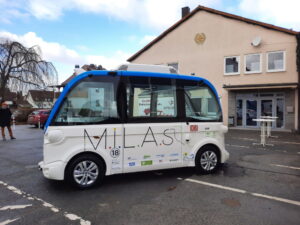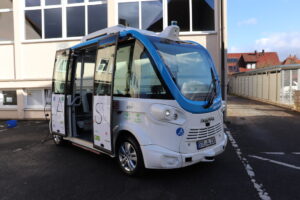 Today we are reporting on a great project in which we at IBC SOLAR were able to participate. It’s about self-driving shuttle buses that are used on a test track in the downtown area of Bad Staffelstein, our company headquarters, and transport citizens and visitors in a climate-neutral way from the health ressort and the thermal baths to the city center.
Today we are reporting on a great project in which we at IBC SOLAR were able to participate. It’s about self-driving shuttle buses that are used on a test track in the downtown area of Bad Staffelstein, our company headquarters, and transport citizens and visitors in a climate-neutral way from the health ressort and the thermal baths to the city center.
The project is called MILAS, which (in German) stands for “Modular intelligent inductive charging systems for autonomous shuttles”. The aim is to test marketable, inductive charging systems for autonomously driving shuttles. Both static charging processes, i.e. while the vehicle is at the stop, and dynamic charging processes during the journey should be possible. The knowledge and experience from the project should later help to transfer the concept to other transport systems, for example at airports or hospitals.
How does the shuttle work?
The electrically powered shuttle is charged contactlessly via several coils built into the road. Two of the inductive charging stations are located at the stops, another “charging lane” is installed in the ring road and enables the shuttle to be charged contactlessly while driving. Since it is an inductive charging process, there is no need for people to start or end the charging process using a cable. Because this type of inductive charging systems is currently not sufficiently researched in public transport, the project makes a valuable contribution to the further development of e-mobility in public spaces.
Benefits for the City
The goal is to significantly and sustainably reduce traffic and emission burdens in German city centers in the long term. This is already being applied in Bad Staffelstein on a small scale through the noiseless and emission-free shuttle system. As part of the MILAS project, the application of this technology in a much more complex network of shuttle lines and charging stations for the city of Munich is also being designed and simulated.
In addition, the shuttles offer a good opportunity to transport people without interruptions over a longer period of time and thus to transform mobility in public spaces in the future.
Thanks to the funding of the project by the Federal Ministry of Economics and the participation of local companies, there are also no costs for the city of Bad Staffelstein, which can continue to use the transport system even after the end of the project phase. During the test phase, the ride with the shuttle is also free of charge.
Other consortium participants of the project, in addition to the city of Bad Staffelstein and IBC SOLAR, are the universities TU Munich and BU Wuppertal, as well as the company Valeo from Kronach. Also, the company INTIS, the Bayernwerk, the DB Regio/OVF and the HUK Coburg are supporting.
Our Contribution
“Since electromobility is only really sustainable when the energy comes from renewable sources like PV, it was a matter of course for us to participate in the project with our expertise and to take over the energy supply,” says Dr. Stratis Tapanlis, head of the C&I Energy Storage department at IBC SOLAR. Our engineers have designed a 50 kWp photovoltaic system and accompanied its installation. The PV system ensures that at least as much clean energy is fed in as the shuttles consume. A 45 kWh storage and an intelligent energy management system complete the system. The configuration of the EMS is also in the hands of the IBC SOLAR engineers and ensures that the shuttles are supplied with clean energy not only in balance but also in real time through the PV storage system.
We are pleased that regular line operation could now start, and we are looking forward to further developments and results from this exciting project. We will certainly report on it again.
Fascinating insights on self-driving shuttle buses powered by PV; innovative and sustainable transport solutions. Well-presented and informative!